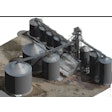In January, during my visit to Two Rivers Cooperative, general manager Tracy Gatham described the cooperative's partnership with local law enforcement to combat methamphetamine production in rural Iowa. In addition to securing the perimeter with basic security measures, the cooperative, in conjunction with Iowa's "Stop Meth" program, began the practice of adding calcium nitrate to its anhydrous ammonia tanks. The method, developed by researchers at Iowa State University (ISU), creates a "chemical lock" that renders the ammonia useless to meth cooks.
Admittedly, this was the first time I had heard about any of this since all I know about this sort of illicit production is from the AMC show, Breaking Bad. Ultimately, this conversation got me thinking about facility security.
Since the Food Safety Modernization Act (FSMA) requires all company's servicing the food chain to develop a food safety plan a la FSMA, Section 103, I decided it was an appropriate time do delve into strategies for critically analyzing and mitigating internal and external security threats. I'd like to share excerpts from an interview with Don Hsieh, director of commercial and industrial marketing with Tyco Integrated Security. When asked where agribusinesses should begin to reevaluating their existing security programs, Hsieh suggested they start with the four common ares of vulnerability:
1) Coating, mixing, grinding, rework areas: These steps in any process can result in the even distribution of a contaminant and can cause greater damage rather than an isolated batch or load;
2) Ingredients staging: A stage in the process that provides access to the production stream;
3) Bulk liquid receiving and loading: There is a high probability of uniform mixing and distribution of a contaminant;
4) Bulk liquid storage or non-bulk liquid holding: Tanks tend to be kept in isolated areas, allowing for easy access to adulteration.
He suggests the best approach to proactive food defense is to assess the measures being taken in these sensitive areas evaluating who has authorization to be in them and how a criminal elements could access the product. After the site has been assessed and access points have been identified, determine alert systems does the company have in place to notify management or staff that there is an incident.
"Anytime there is an incident, the faster the response to the incident the quicker the recovery," Hsieh says, noting that alerts range from testing to virtual products like cameras or the use of RFID technology.
The final step is auditing the security measures you have implemented so "you don't think you're in compliance, you know you're in compliance."
While the specifics of site security, rely heavily on the site itself, starting with the basics is the best way to protect your business and the food supply.









